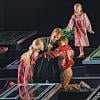
Intelligence opens quietly, its only sound the flapping of laundry. Don’t be fooled — this new opera, which had its world premiere Friday night at Houston Grand Opera, is anything but subtle. A percussive score by Bay Area-based Jake Heggie, a grandiose libretto by Gene Scheer, exaggerated characters, and visceral physicality courtesy of director/choreographer Jawole Willa Jo Zollar and the Urban Bush Women dancers combine for a night of big sounds, big movements, and big emotions.
The opera revolves around two historical figures: Mary Jane Bowser, an enslaved woman who spied in the Confederate White House during the American Civil War, and Elizabeth Van Lew, a wealthy Richmond landowner who ran that Union spy operation (and whose family Mary Jane was enslaved to). The opera’s creators have woven a fanciful story around both women’s lives. The plot is driven in equal parts by the dangers of spying (Confederate Home Guard Travis and Elizabeth’s sister-in-law Callie suspect Elizabeth’s treason) and the angst of personal discovery as Mary Jane responds to betrayals, romantic overtures, and the approaching end of the war.
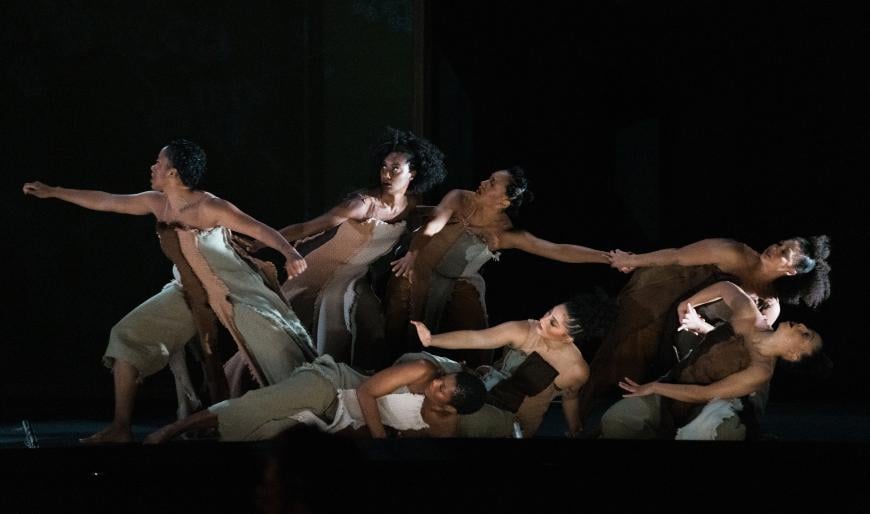
A lot happens in less than two and a half hours, so the plot proceeds at a thrilling pace. If its contents are sometimes absurd (for example, Travis’s over-the-top mustache-twirling villainy), isn’t that the prerogative of opera? More frustrating is the libretto’s occasional descent into cliches. Scheer’s writing sparkles in conversational exchanges but struggles in some of the arias, where flowery phrases ring false.
The tuneful score twists as quickly as the plot. It moves from slow, sweeping melodic lines to punctuated rhythms and back again, often within a single aria or duet. Heggie playfully incorporates a variety of inspirations and techniques: jazzy chromatics, nods to blues and spirituals, literal tone painting of text, realistic sound effects (most disturbingly, the cracking of whips and clinking of chains), and ironic repetition of motifs. The music often swells to huge proportions, with multiple voices singing fortissimo above crashing percussion, but Heggie balances this with moments of touching simplicity. A stunning Act 2 duet for Callie and Elizabeth (“chained to you,” they sing) layers their voices a cappella for several verses before the orchestra softly joins in. The Houston Grand Opera Orchestra, led by conductor Kwamé Ryan, delivered this variety of styles and dynamics with contagious energy and without ever overpowering the cast.
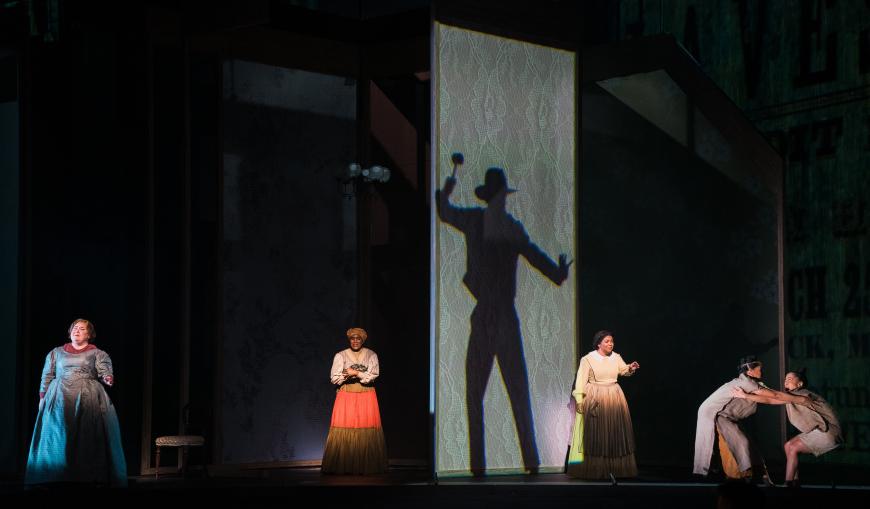
And what a cast! As Mary Jane, soprano Janai Brugger complemented a grimly determined persona and steely core of sound with warmth of voice and feeling. Unfailing legato and effortlessly floated high notes shone in her final aria (“my momma’s eyes,” she sings). Mezzo-soprano Jamie Barton played Elizabeth with a self-assured sparkle in her eye, deploying her chest voice for comedic effect and letting her top register ring. Some inconsistency in her middle range was evident in the first act but resolved by the second. J’Nai Bridges’s mezzo-soprano alternately soared with crystal clarity and cracked with brittle pain, reflecting the trauma of her character, Lucinda. Soprano Caitlin Lynch made Callie a not-so-innocent ingenue through simpering manners, silvery tone, and clean onsets. Baritone Michael Mayes’s huge sideburns, expressive eyebrows, and gruff voice perfectly suited Travis. Nicholas Newton’s Henry sported a soothing, seductive bass-baritone with punchy consonants, while Joshua Blue’s bright, nasal tenor and darting eyes matched Wilson’s timidity.
Alongside this small cast, the eight-woman dancer-chorus expresses characters’ emotions, mimes scenes, and embodies absent ancestors. Onstage for nearly the entire opera, they twirl, stomp, and leap with abandon.
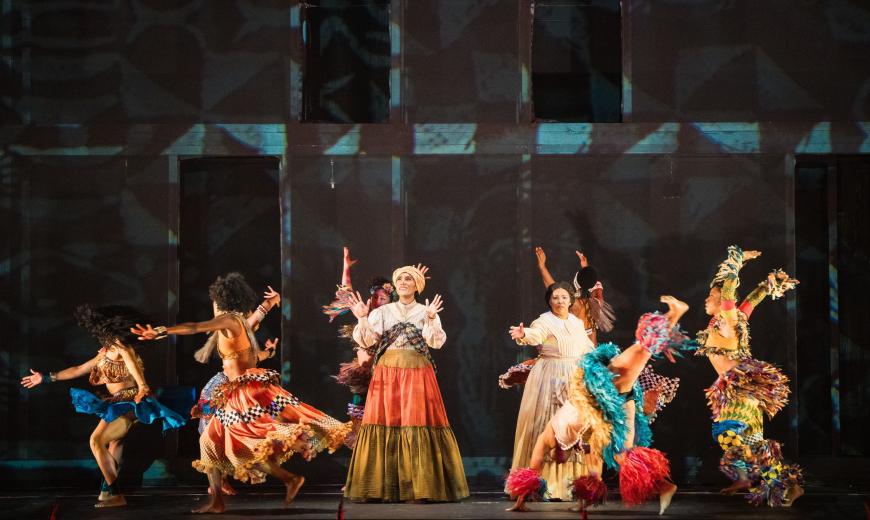
They sit outside the opera’s historical world, showing Mary Jane the past (a “dance of the ancestors” in traditional garb proves the climax of Act 2), supporting her in the present (offering solicitous looks and uplifting hands as she enters the Confederate White House), and encouraging her future (closing the opera with an athletic display in neon orange sweats). The expressive dancing lends a vital part of the opera’s appeal. However, its attention-grabbing explosivity can distract from the singers, especially because their aimless blocking compares unfavorably with the precise choreography.
All this action unfolds on Mimi Lien’s stunning set, whose two-story rotating centerpiece and myriad flying panels transform miraculously between scenes. With the help of Wendall K. Harrington and Rasean Davonté Johnson’s immersive projections and John Torres’s clever lighting design, the same few pieces alternately become Elizabeth’s “house on the hill,” the stately Confederate White House, and a giant moonlit oak tree. Fabric plays an important thematic role in the opera, and costume designers Carlos Soto and Clair Hummel respect that through historically accurate, intricately crafted garments, from a lace-trimmed pink ball gown for Jefferson Davis’s wife to Mary Jane’s practical pin-tucked day dress.
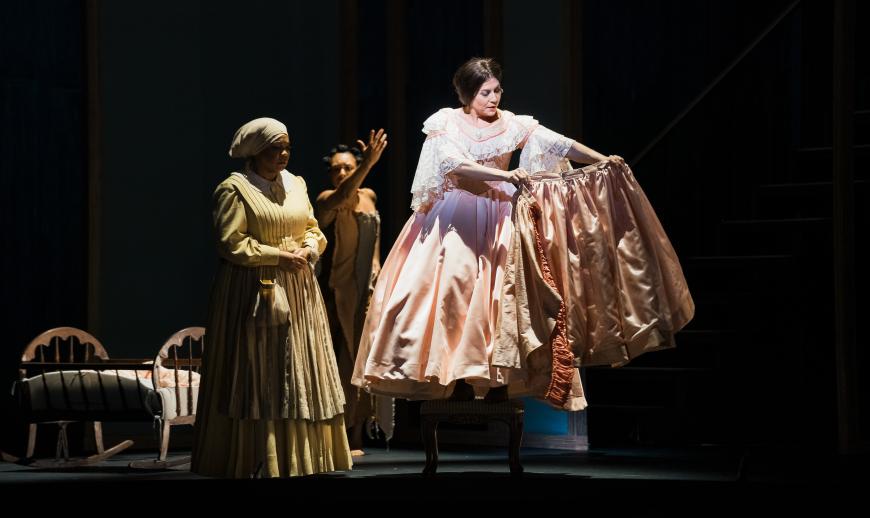
Audience members chattered about Intelligence’s choreographic echoes of Hamilton, and it shares another feature with the hit musical: Its characters obsess about narrative. They ask over and over whether their story will be told, whether truth will prevail over lies. Of course, very little of the opera is historical truth; its most searing moments are pure invention. But Heggie, Scheer, and Zollar’s powerful storytelling ensures that this tale will unfold on opera stages for years to come.




